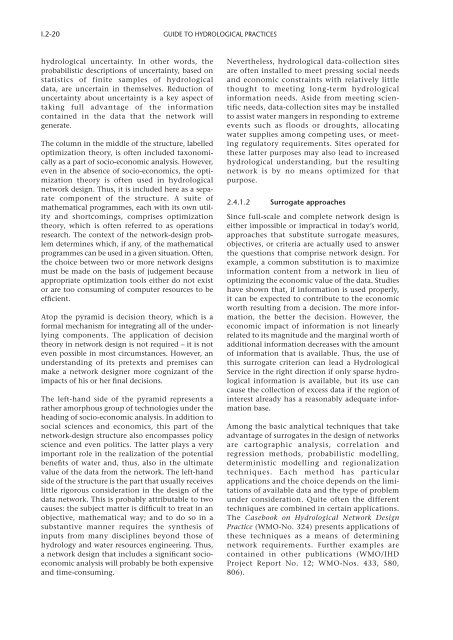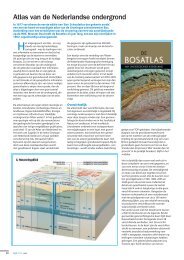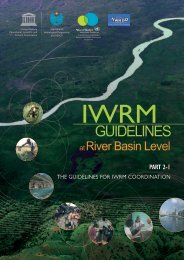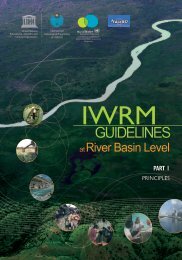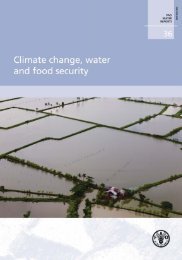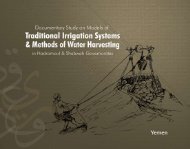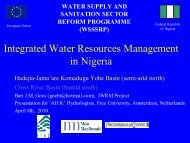Guide to Hydrological Practices, 6th edition, Volume I - Hydrology.nl
Guide to Hydrological Practices, 6th edition, Volume I - Hydrology.nl
Guide to Hydrological Practices, 6th edition, Volume I - Hydrology.nl
Create successful ePaper yourself
Turn your PDF publications into a flip-book with our unique Google optimized e-Paper software.
I.2-20<br />
GUIDE TO HYDROLOGICAL PRACTICES<br />
hydrological uncertainty. In other words, the<br />
probabilistic descriptions of uncertainty, based on<br />
statistics of finite samples of hydrological<br />
data, are uncertain in themselves. Reduction of<br />
uncertainty about uncertainty is a key aspect of<br />
taking full advantage of the information<br />
contained in the data that the network will<br />
generate.<br />
The column in the middle of the structure, labelled<br />
optimization theory, is often included taxonomically<br />
as a part of socio-economic analysis. However,<br />
even in the absence of socio-economics, the optimization<br />
theory is often used in hydrological<br />
network design. Thus, it is included here as a separate<br />
component of the structure. A suite of<br />
mathematical programmes, each with its own utility<br />
and shortcomings, comprises optimization<br />
theory, which is often referred <strong>to</strong> as operations<br />
research. The context of the network-design problem<br />
determines which, if any, of the mathematical<br />
programmes can be used in a given situation. Often,<br />
the choice between two or more network designs<br />
must be made on the basis of judgement because<br />
appropriate optimization <strong>to</strong>ols either do not exist<br />
or are <strong>to</strong>o consuming of computer resources <strong>to</strong> be<br />
efficient.<br />
A<strong>to</strong>p the pyramid is decision theory, which is a<br />
formal mechanism for integrating all of the underlying<br />
components. The application of decision<br />
theory in network design is not required – it is not<br />
even possible in most circumstances. However, an<br />
understanding of its pretexts and premises can<br />
make a network designer more cognizant of the<br />
impacts of his or her final decisions.<br />
The left-hand side of the pyramid represents a<br />
rather amorphous group of technologies under the<br />
heading of socio-economic analysis. In addition <strong>to</strong><br />
social sciences and economics, this part of the<br />
network-design structure also encompasses policy<br />
science and even politics. The latter plays a very<br />
important role in the realization of the potential<br />
benefits of water and, thus, also in the ultimate<br />
value of the data from the network. The left-hand<br />
side of the structure is the part that usually receives<br />
little rigorous consideration in the design of the<br />
data network. This is probably attributable <strong>to</strong> two<br />
causes: the subject matter is difficult <strong>to</strong> treat in an<br />
objective, mathematical way; and <strong>to</strong> do so in a<br />
substantive manner requires the synthesis of<br />
inputs from many disciplines beyond those of<br />
hydrology and water resources engineering. Thus,<br />
a network design that includes a significant socioeconomic<br />
analysis will probably be both expensive<br />
and time-consuming.<br />
Nevertheless, hydrological data-collection sites<br />
are often installed <strong>to</strong> meet pressing social needs<br />
and economic constraints with relatively little<br />
thought <strong>to</strong> meeting long-term hydrological<br />
information needs. Aside from meeting scientific<br />
needs, data-collection sites may be installed<br />
<strong>to</strong> assist water mangers in responding <strong>to</strong> extreme<br />
events such as floods or droughts, allocating<br />
water supplies among competing uses, or meeting<br />
regula<strong>to</strong>ry requirements. Sites operated for<br />
these latter purposes may also lead <strong>to</strong> increased<br />
hydrological understanding, but the resulting<br />
network is by no means optimized for that<br />
purpose.<br />
2.4.1.2 Surrogate approaches<br />
Since full-scale and complete network design is<br />
either impossible or impractical in <strong>to</strong>day’s world,<br />
approaches that substitute surrogate measures,<br />
objectives, or criteria are actually used <strong>to</strong> answer<br />
the questions that comprise network design. For<br />
example, a common substitution is <strong>to</strong> maximize<br />
information content from a network in lieu of<br />
optimizing the economic value of the data. Studies<br />
have shown that, if information is used properly,<br />
it can be expected <strong>to</strong> contribute <strong>to</strong> the economic<br />
worth resulting from a decision. The more information,<br />
the better the decision. However, the<br />
economic impact of information is not linearly<br />
related <strong>to</strong> its magnitude and the marginal worth of<br />
additional information decreases with the amount<br />
of information that is available. Thus, the use of<br />
this surrogate criterion can lead a <strong>Hydrological</strong><br />
Service in the right direction if o<strong>nl</strong>y sparse hydrological<br />
information is available, but its use can<br />
cause the collection of excess data if the region of<br />
interest already has a reasonably adequate information<br />
base.<br />
Among the basic analytical techniques that take<br />
advantage of surrogates in the design of networks<br />
are car<strong>to</strong>graphic analysis, correlation and<br />
regression methods, probabilistic modelling,<br />
deterministic modelling and regionalization<br />
techniques. Each method has particular<br />
applications and the choice depends on the limitations<br />
of available data and the type of problem<br />
under consideration. Quite often the different<br />
techniques are combined in certain applications.<br />
The Casebook on <strong>Hydrological</strong> Network Design<br />
Practice (WMO-No. 324) presents applications of<br />
these techniques as a means of determining<br />
network requirements. Further examples are<br />
contained in other publications (WMO/IHD<br />
Project Report No. 12; WMO-Nos. 433, 580,<br />
806).


